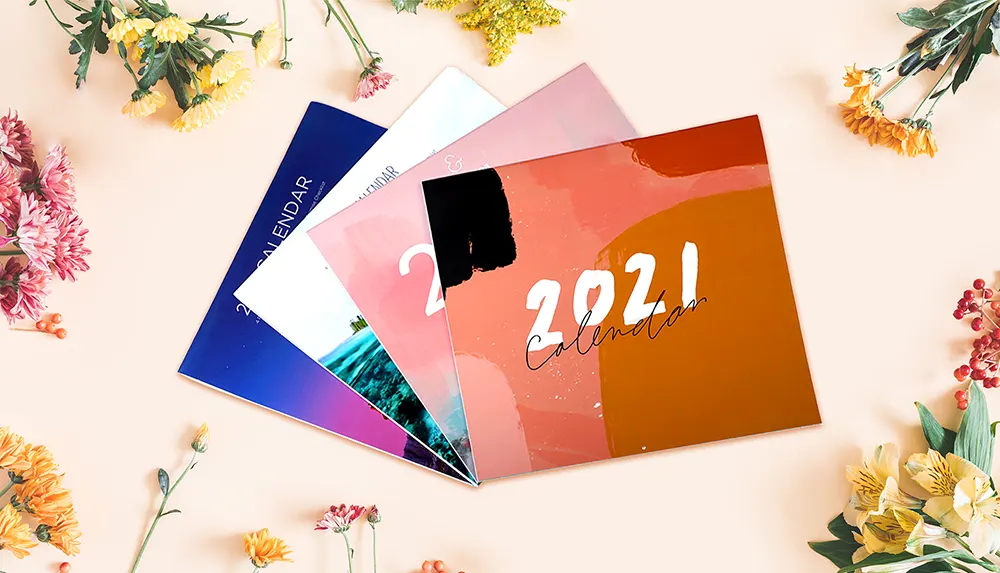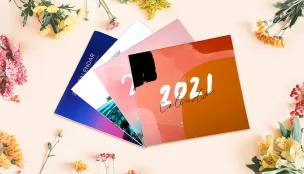
Printed calendars retain a perennial popularity. Despite the proliferation of online calendars, electronic organizers, and planning apps for your smartphone, the custom printed wall calendar is an enduring feature of almost every American home and office. Smart businesses of all sizes know this and that's why most produce a commercial, branded calendar each year. Calendars can be used to promote your business, remind customers of your brand and products, and attract new custom. You can also give them away as corporate gifts or at business-to-business events, trade fairs, and conferences.
People love printed calendars
A recent calendar usage study for Bankers Advertising made the following fascinating findings:
- 78% of people interviewed said they had a printed calendar in their place of work
- 79% said they liked getting printed calendars as gifts
- Printed wall calendars are most popular, followed by desk calendars, and then pocket calendars
- 94% said they keep — and use — free promotional calendars
- Printed calendar usage is 67% higher than digital calendar usage
Printed calendars are interactive spaces
But that's not all. The same study went on to look at the way people use printed calendars both at home and in work settings. When you're designing your own commercial calendar, it's helpful to know how people will use them, so that you can make them as user-friendly and valuable as possible. Here's what the study found:
- Not surprisingly, most people— 83% — use a printed calendar to check dates!
- 84% note down meetings and appointments on them
- 52% use them to write down personal or business-related notes
- 77% use them to follow holidays, sporting events, birthdays, and so on
People also use their printed calendars to track expenses, jot down contact details, telephone numbers, and more. What can you learn from these data? Well, the big takeaway in terms of promotional calendar design is that calendars are interactive. So, any design elements you can include which facilitate their practical application and make them more useful is worth thinking about. Building in spaces on each page for lists, notes, and memos, for example.
Printed calendars are powerful marketing tools
Just a few more statistics before we drill down into the top tips for designing and printing your business's own successful promotional calendar. These are from the section of the survey which looked at how well printed calendars deliver as marketing tools. It seems that very little beats them. Here're the numbers:
- 75% of people with a promotional calendar remembered the name of the company who'd produced it
- 77% could name the company's products as advertised on the calendar
- 77% of people eventually went on to buy something from the company behind the calendar
- 48% shared the calendar with others
The numbers don't lie. But this isn't just about proving that an investment in printed promotional calendars is likely to give any business — large or small — a significant return on investment. It's also because we can learn a lot about what makes a good calendar from these findings. So, here are five top tips to keep in mind when you come to design and print your wall calendar.
5 tips for successful promotional calendars
1. Make it eye-catching and attractive
Do you remember that the most popular format of calendar is the wall hanging variety? These are usually larger — even up to poster-sized — and so they should be highly visual. Think about commissioning high-quality, professional photography for each page. Products-in-use, inspirational lifestyle images, pithy quotations, humor, and thematic ideas are all proven to work well.
Making your calendar as visually attractive as possible isn't just a question of pleasing the person to whom you originally give it. As most calendars end up in the workplace — the office, the store, or the factory floor, for example — it also helps to make sure that other people see it, notice it, and absorb the marketing messages it communicates. A calendar that goes out to one person is likely to be seen by hundreds, thousands, or even more people during the course of a year. That's a lot of free exposure for your brand and your marketing messages.
2. Get it professionally designed — with the user in mind
Always use a professional designer to create your promotional calendars. Unless you are an expert in print design and design software yourself, you will need to outsource this side of things to a professional if you want your calendar to be beautiful and functional. At Qin Printing, we have our own in-house designers which can speed up the process as they're already knowledgeable about our print parameters and experienced with both digital and offset printing technology.
If needed, we can supply you with templates, too. In any case, it's always a good idea to get your printer onboard at the design stage as they'll be able to provide all kinds of vital information about materials and processes— paper, finishes, inks, and bindings, for example — and ideas about optimal formats, sizes, bleed area, trim lines, and more, best suited to your calendar project.
Creating a design brief is always exciting. But remember that the calendar is not only a useful organizer and a work of art. Above all, it's a marketing tool. For that reason, every element of the design should be focused on the customer's interests, needs, and values. This can impact everything from your choice of images to the kinds of special dates and events you opt to highlight to the range of the calendar; which could follow a solar year, a lunar year, an 18-month crossover, the academic year, or the financial year, for example.
3. Design your calendar around a theme
An important aspect of your overall calendar design is that it is conceptually coherent. So, make sure that you build your calendar around a theme. The theme could be a particular product range — say, outdoor furniture or seasonal fashion collections — to sporting events, important people, staff biographies, or customer testimonials. Only you can decide what will interest your customers, but a calendar with a recognizable theme running throughout the year is more unified and interesting than one with disconnected ideas on each page.
4. Choose paper that your customers can write on
As you'll remember, a custom printed calendar is an interactive tool. Whether in pencil, with a Biro, or a Sharpie, people love to write on their calendars. So, beyond designing enough white space for them to do that, you need to make sure that the choice of paper and the finish or coating are suitable. If the paper is too glossy, it may not be easy to scribble notes, reminders, events, and contact details onto the surface. Your printer will be able to advise you about the range of suitable paper types, weights, and coatings that are available.
5. Include contact information, your website details, and a special offer
To really make the most of your promotional printed wall calendar as a marketing tool, don't forget to include your contact details — business address, email, and telephone — in a prominent position on every page. You should also add your website URL and even a QR code, so that customers can scan it with their smartphones and go straight to your website, blog, or online catalog. It's a great idea to include a special discount offer code, too, to encourage engagement. That way, your calendar doesn't only promote your products and services, but drives traffic to your website and allows you to gather consumer data which you can use to refine your marketing in the future.
Let's make a date!
We're confident that you'll see just how much marketing and promotional work a well-designed custom wall calendar can do for your business. We've been helping businesses just like yours to design and print calendars and other promotional materials for decades, so we know a thing or two about it. We'd love to see your business benefit from this low investment, high return marketing tool, too. Get in touch today for a no-obligation quote or just to chat through your ideas. Let's make a date!







